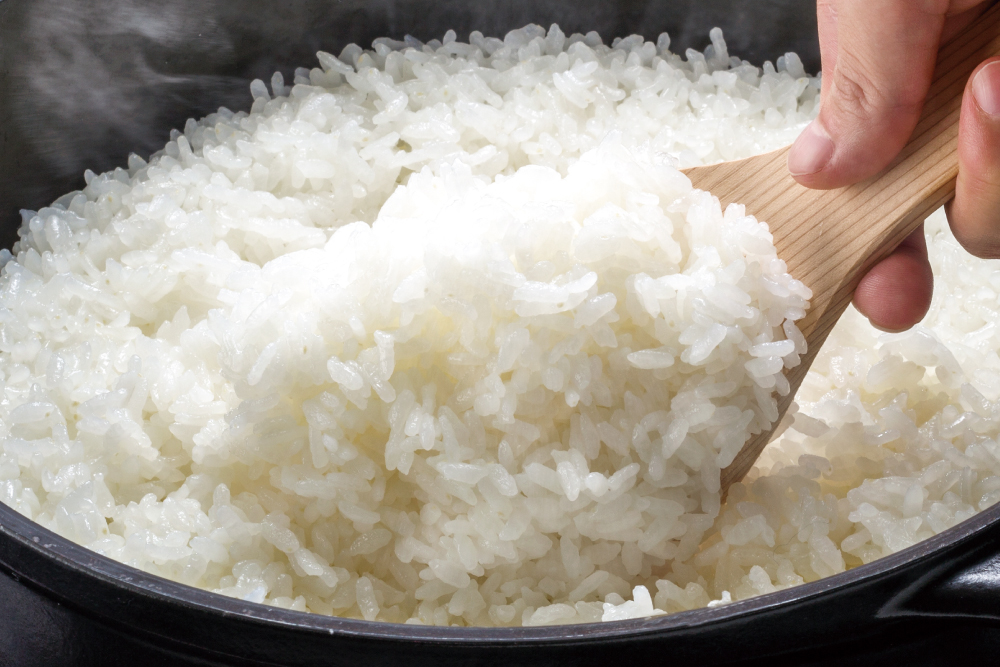

The Love We Put Into Our Riceこの米に込めた想い
「ASAKAMAI 887」の生産で培われた
極上の食べ心地
明治時代、不毛の大地だった安積原野を切り拓き、猪苗代湖の豊富な水を引き込んだ安積疏水により、福島県郡山市は豊かな水田が広がる県内で最も米作りが盛んな土地になりました。
この地で育てられた郡山産のブランド米「あさか舞」を皮切りに、どこよりも安全で美味しい最高峰の米を目指して栽培に取り組み、挑戦し続けている日本一厳しい出荷基準を満たした最高級米ブランド「ASAKAMAI 887」このプロダクトは、郡山市の米生産者が誇る、揺るぎない品質とプライド、研究/開発の試行錯誤による賜物です。
887の生産によって、培われた生産技術とノウハウを落とし込み、極上の食べ心地を目指し、日々の食卓やお弁当などで皆様に郡山産米の美味しさを楽しんでいただける新商品を開発いたしました。
「ASAKAMAI2.0」を是非ご賞味ください。
Asakamai 2.0
Longer Grains of Koshihikari Rice: More Flavor, Better Texture
During the Meiji era (1868–1912), the Asaka Land Development and Canal Project was launched to bring water from Lake Inawashiro to the parched Asaka Plains. The water provided by the Asaka Canal enriched the rice production in the area, turning Koriyama into the biggest producer of rice in the prefecture.
With our Koriyama brand rice “Asakamai” we are dedicated to deliver the most delicious and high-quality rice that fulfills Japan’s most strict standards. Our Asakamai 887 is the result of research and a long trial and error process.
By applying the production technologies and know-how that we have cultivated through the production of Asakamai 887, we have developed a new product that offers an even better flavor and more unique mouthfeel for everyone to enjoy in their lunch boxes and recipes. We call it: “Asakamai 2.0.”
大粒由来の特徴
・粒立ちが良い
・甘みや香りを感じやすい
・舌触り、歯ごたえが良い
Characteristics of this rice derived from its large grains
Good graininess
Easy to perceive sweetness and aroma
Good texture and crunchiness

The reason for the superb eating comfort.極上の食べ心地な理由
ふるい目 - Sieve Slots
-
2.0mm
1.8〜1.9mm幅のふるい目が一般的ですが、2.0mmのふるい目を使用し大粒のお米のみを選別。粒ぞろいが非常に良いことから、口に入れたときの舌や歯ざわりが良く、食味が向上します。
Rice that makes it through sieve slots 1.8-1.9mm wide are the norm, but we select only large-grain rice that gets through 2.0mm sieve openings. As the grains are high quality and uniform in size, the rice has excellent texture and improved taste.
整粒歩合 - Ratio of Perfect Grains
-
80%
以上
米の状態を見極める基準のひとつで、一定量の玄米のなかで、きちんと整った形をしている米粒の割合を%で示した値です。一等米で70%以上で、それを上回る基準を設けています。
One standard for ensuring rice quality is the proportion of perfectly formed rice grains, expressed as a percentage value. The value is 70 percent or more for first-class rice, and our own standard is set even higher.
特別栽培米 - Specially-cultivated Rice
国が定めた「特別栽培農産物に係る表示ガイドライン」に基づき、慣行米より「節減対象農薬の使用回数が50%以下、化学肥料の窒素成分量が50%以下」で栽培された米。福島県特別栽培農産物認証制度による認証を受けることが条件となります。
Based on the “Display Guidelines Related to Specially-Cultivated Agricultural Products” set by the government, our rice is grown with “a 50 percent or less instances of agrochemical use, and 50 percent or less of the nitrogen component amount in chemical fertilizers” compared to conventional rice. The rice must be certified under the Fukushima Prefecture Specially-Cultivated Agricultural Product Certification System.
GAP認証 - GAP Certification
ASAKAMAI 887の生産者は、農業の生産工程の管理に取り組むGAP認証を受けています。生産現場において食品の安全確保、環境の保全、労働の安全などの観点から安全に農業生産を実施するための管理ポイントを整理しそれぞれを記録・検証して農業生産を行っている生産者によって栽培された米です。
Producers of ASAKAMAI 887 are GAP certified to manage their agricultural production processes. The rice is grown by producers who organize, record, and verify control points for safe agricultural production from the perspectives of food safety, environmental conservation, and labor safety at the production site.
カーボンニュートラル水田 - Carbon neutral paddy fields
温暖化に影響するメタンガス。水田からのメタンガス発生を抑制するための取り組みとして、中干し期間を通常よりも延長することで、土壌中により多くの酸素が供給され、メタン生成菌の活動を抑制し、温室効果ガスの排出量を低減させる配慮がなされた水田で栽培されています。
Methane gas affects global warming. In an effort to reduce methane gasemissions from rice paddies, the paddies are cultivated in consideration of suppressing the activity of methanogenic bacteria and reducing greenhouse gas emissions by supplying more oxygen to the soil and by extending the drying period longer than usual.
